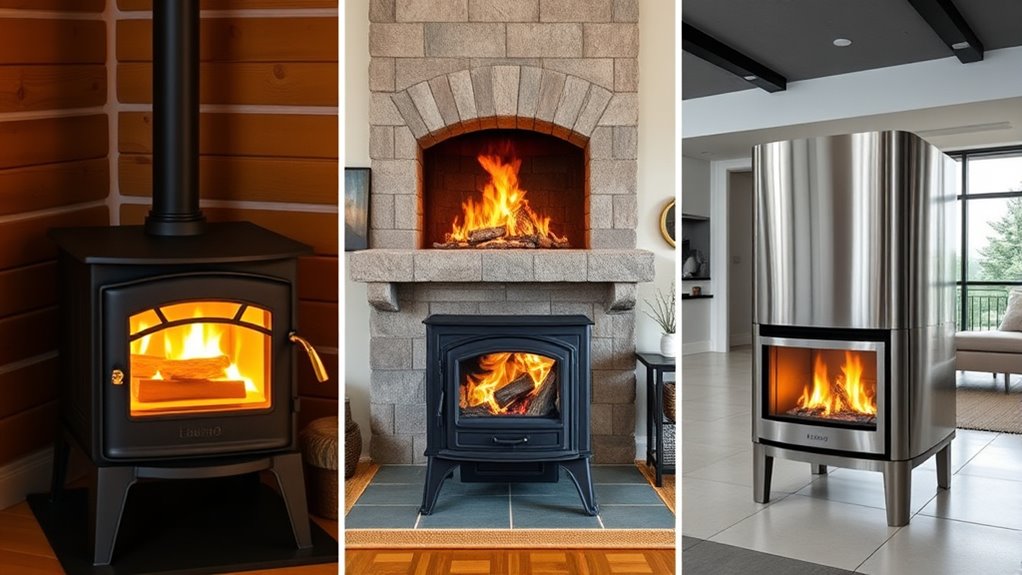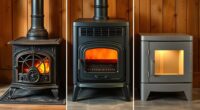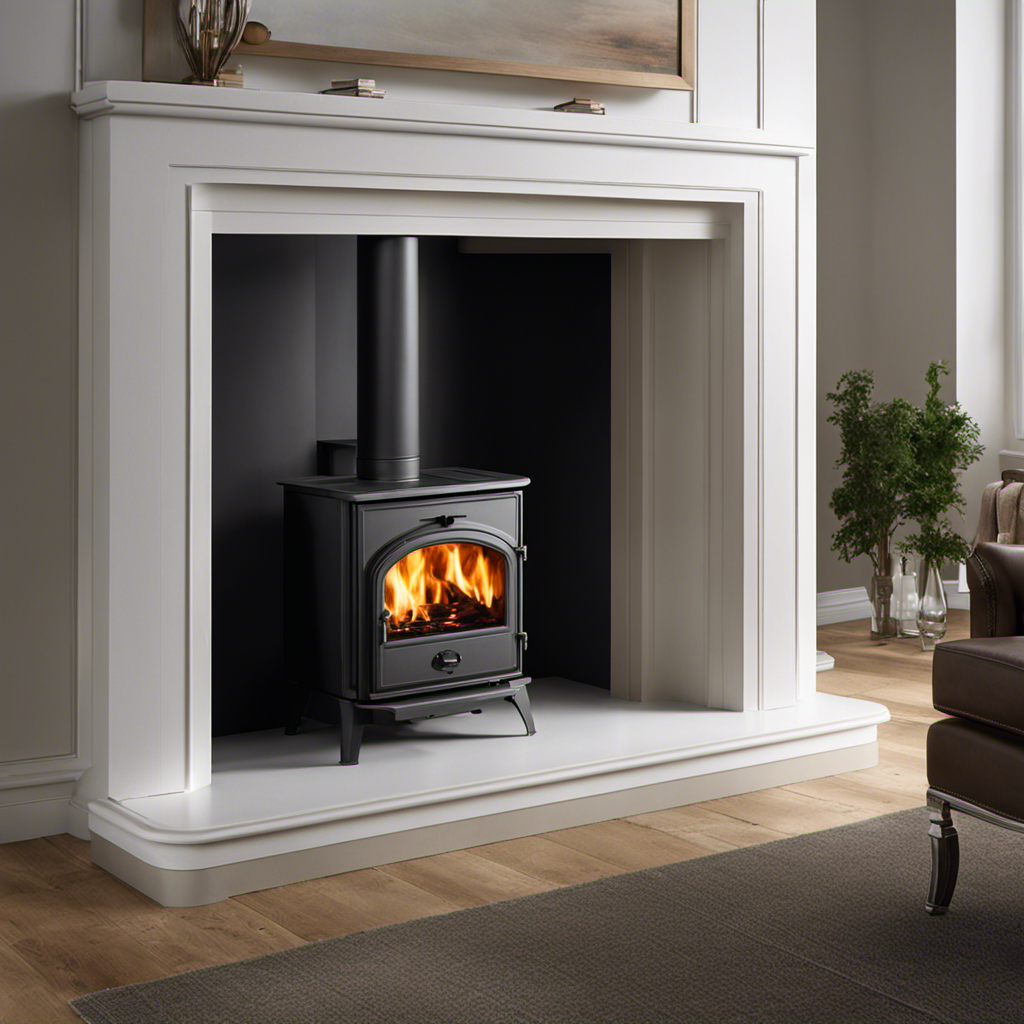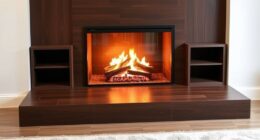Choosing the right wood stove size depends on your home’s square footage, insulation, and layout. Smaller spaces up to 500 sq ft need 4-6 KW stoves, while larger homes over 2,200 sq ft require extra-large models with higher BTU ratings. Proper sizing guarantees efficient heating and safety. To get the best fit, consider using a stove size calculator and consulting professionals. Keep exploring to find detailed tips for your specific home size.
Key Takeaways
- Match stove size and BTU capacity to your home’s square footage and cubic volume for efficient heating.
- Consider room insulation, layout, and ceiling height to determine appropriate stove size and heat output.
- Use stove size calculators that analyze your home’s features to recommend suitable KW ratings.
- Larger homes or open plan areas require higher-capacity, extra-large stoves for effective warmth.
- Consult professionals to ensure proper sizing, installation clearance, and safety compliance for optimal performance.
Understanding the Basics of Stove Sizing Based on Square Footage
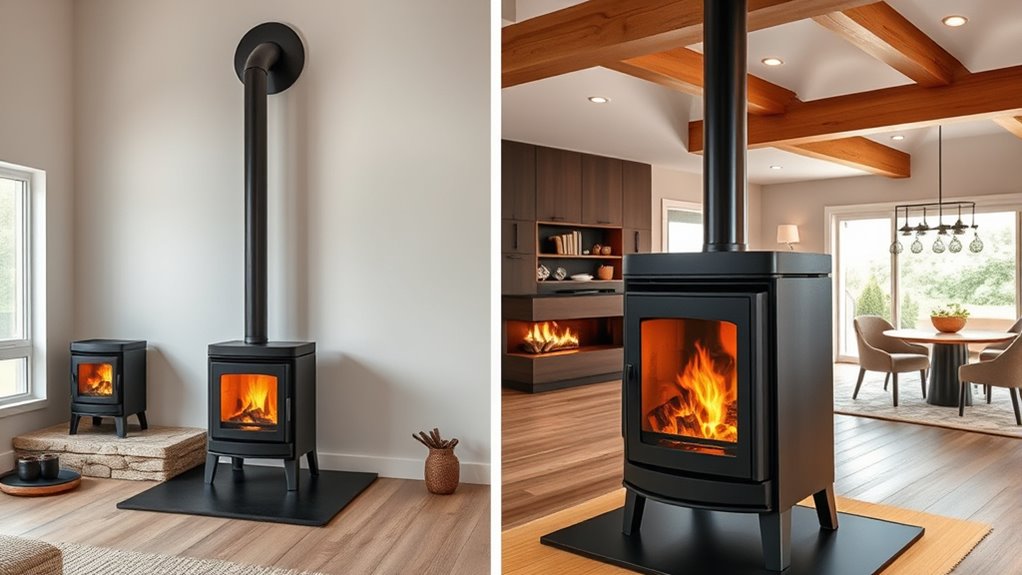
To choose the right wood stove for your home, it’s essential to understand how to size it based on your space’s square footage. Your goal is to match the stove size with your room size to guarantee proper heating capacity and efficiency. Larger homes over 2200 sq ft need extra-large stoves with higher BTU output and KW requirements, while smaller spaces up to 500 sq ft typically only need 4-6 KW stoves. To estimate the right stove heat output, multiply your room’s width, length, and height to find cubic footage, then divide by 14. Proper stove sizing assures home heating, reduces creosote buildup, and maximizes performance. Understanding performance cookies can help optimize your heating system’s efficiency and safety. Additionally, considering stove efficiency ratings can help you select models that save energy and reduce fuel consumption. Selecting the appropriate size also contributes to safer operation and minimizes fire hazards in your home. Using the right size stove also helps improve overall home comfort by providing consistent warmth and reducing cold spots. Knowing the proper installation guidelines is crucial for ensuring your stove operates safely and efficiently, according to manufacturer specifications.
Calculating the Ideal Stove Size Using Room Dimensions and Layout
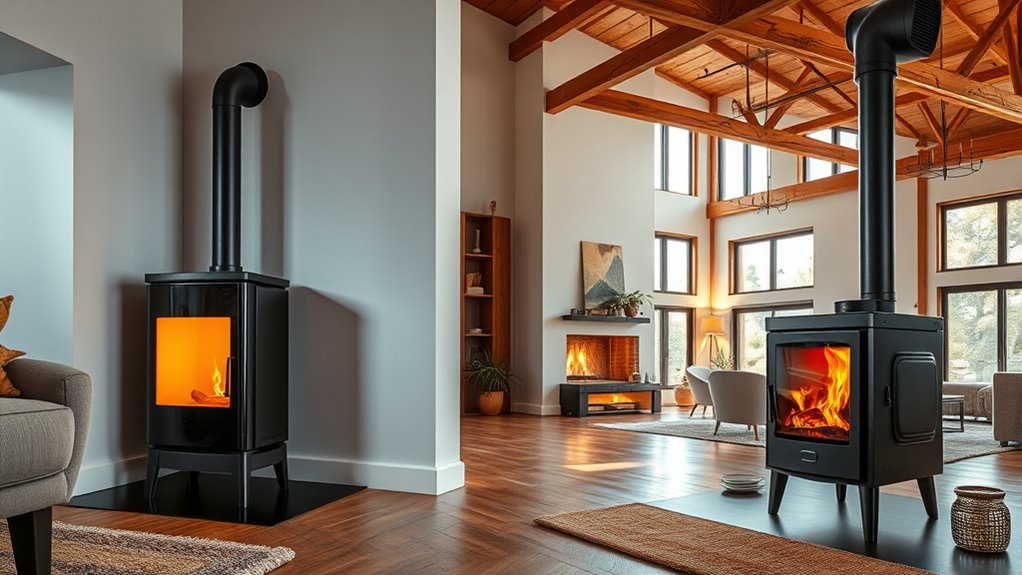
| Room Features | Effect on Stove Size |
|---|---|
| Well-insulated, small windows | Lower heat output requirements. Proper ventilation can also influence stove performance and safety considerations. Additionally, good insulation reduces heat loss, allowing for a smaller stove to effectively heat the space. Good insulation techniques can further optimize heating efficiency. |
| Open plan, large windows | Higher heat output needed. Adequate ventilation helps maintain safety and efficiency. Properly designed open layouts can improve heat circulation, but may require larger stoves for consistent warmth. Proper layout planning can enhance heat distribution throughout the space. |
| High ceilings | Larger stove capacity required. Incorporating insulation quality can mitigate some heat loss. High ceilings can cause heat to rise, so selecting a stove with sufficient capacity is essential for maintaining comfortable temperatures. Additionally, high ceilings may increase the overall heating demand. |
| Compact, segmented layout | Smaller stove may suffice. Optimal layout planning can enhance heating efficiency. Thoughtful space planning can maximize heating effectiveness and reduce the need for a larger stove. This approach ensures even heat distribution and energy efficiency. |
Features of Wood Stove Size Calculators and How They Assist in Selection
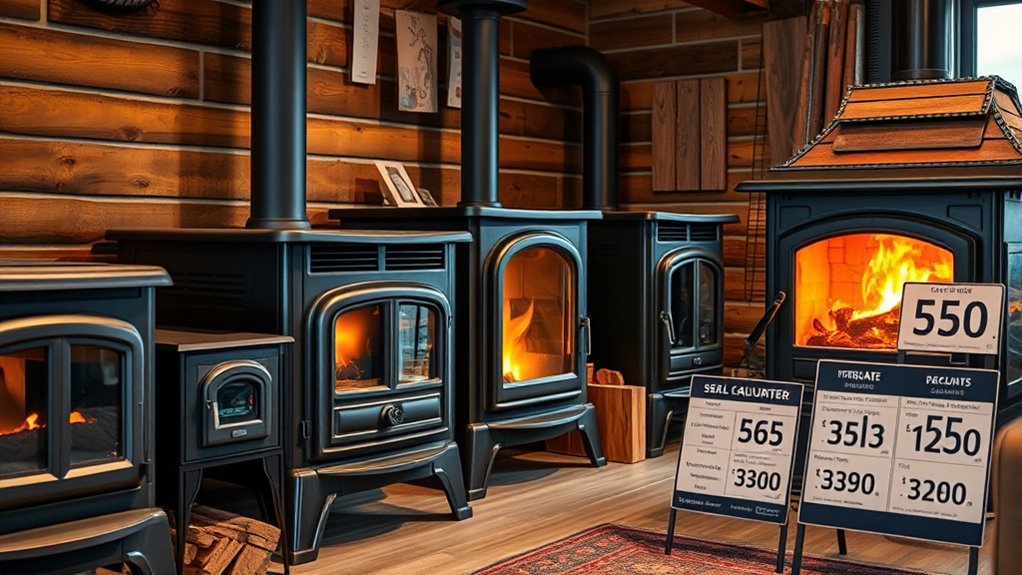
Wood stove size calculators are valuable tools that help you determine the appropriate heating capacity based on your home’s specific characteristics. These tools analyze factors like room volume, insulation quality, and layout to recommend stove sizing that matches your needs. By inputting room dimensions and other details, you can estimate the kilowatt needs for efficient heating. Advanced calculators go further, considering your preferred indoor temperature, open-plan or segmented spaces, and climate zone, refining recommendations. Many tools provide guidance beyond simple square footage, helping you choose between small, medium, or larger stoves or even fireplace inserts. Understanding narcissistic traits in your household or community can also influence your heating needs, as emotional comfort is an important aspect of overall well-being. Additionally, remote work habits may influence your heating requirements, since increased time spent at home can affect energy consumption. Incorporating energy efficiency principles can optimize your stove’s performance and reduce costs. Considering household habits can further enhance your heating strategy by aligning stove size with daily usage patterns. Furthermore, knowing the cost of energy in your area can help you select a stove that minimizes operating expenses. While these calculators offer essential insights, it’s recommended to follow up with a professional assessment to guarantee your selected stove maximizes efficiency and comfort.
Key Factors That Influence the Appropriate Stove Size for Your Home
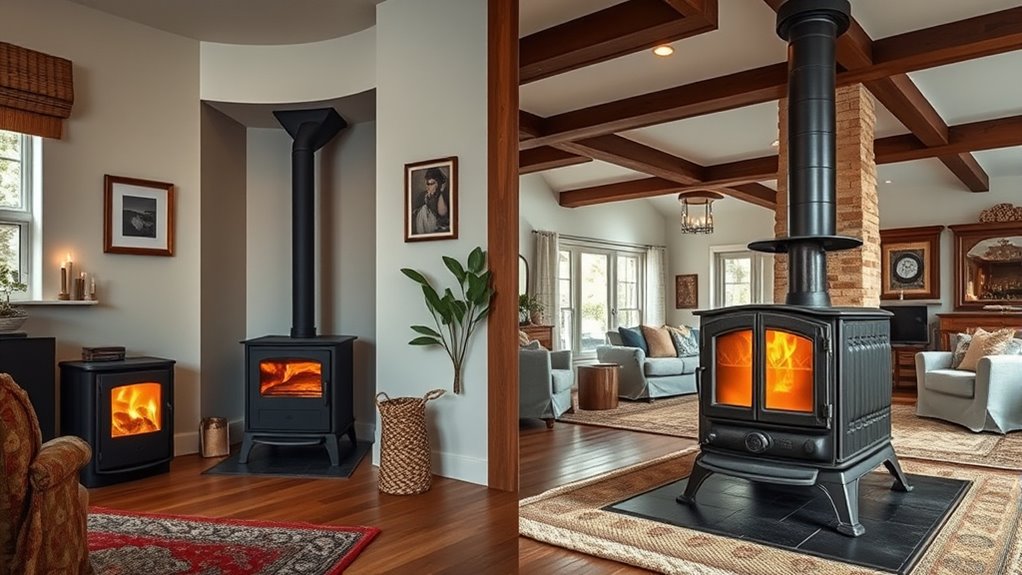
The right stove size depends on several key factors that directly impact how much heat your home needs. Your home insulation, for example, determines whether a smaller or larger wood stove size is appropriate, as poorly insulated homes require higher heating capacity. The home layout influences heat distribution; open plans need more BTU output than segmented spaces. Climate zone affects stove size because colder areas demand larger stoves or supplementary heat sources. Additionally, the type of wood impacts burn time and stove efficiency, altering heating capacity needs. Consider the table below to better understand these factors: proper sizing techniques ensure you select a stove that efficiently and safely heats your home.
Additional Tips for Ensuring Proper Fit and Optimal Heating Performance
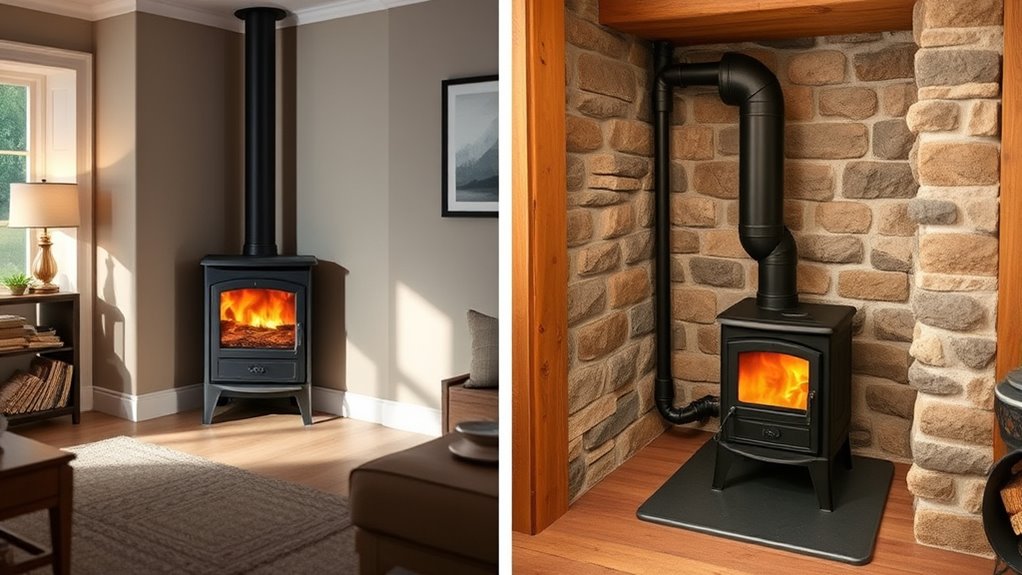
Ensuring your wood stove fits well and heats efficiently requires careful measurement and planning. To achieve proper fit and ideal heating performance, consider these tips:
- Accurately measure your space to determine the right stove size that matches your room’s heat needs.
- Use a wood stove size calculator that accounts for room layout, insulation quality, and BTU output.
- Verify installation clearance to ensure safety and compliance with manufacturer guidelines.
- Consult a certified wood stove professional to confirm that your chosen stove provides balanced heat efficiency without overheating.
- Regularly updating your understanding of safety regulations and installation best practices can help prevent hazards and maintain optimal operation.
- Staying informed about local fire safety codes and ensuring your stove setup adheres to these standards is essential for safe and efficient operation.
- Considering the efficiency ratings of different models can help you select a stove that maximizes heat output while minimizing fuel consumption.
- Additionally, understanding ventilation requirements can contribute to better stove performance and safety.
Frequently Asked Questions
What Is the 3:2-10 Rule for Wood Stoves?
The 3:2-10 rule guides you when choosing a wood stove by suggesting you select a stove with about 3 cubic feet of capacity for every 2 rooms and roughly 10 square feet of space per cubic foot. This helps you match your stove’s heat output to your home’s size, ensuring efficient warmth without overheating. Remember to contemplate other factors like insulation and layout for perfect sizing.
What Size Wood Stove Do I Need for My House?
Think of your home as a cozy fire needing just the right-sized log. To pick the right wood stove, measure your space. If your home is small, under 500 sq ft, a 4-6 KW stove will do. For medium-sized homes, 7-9 KW works best. Larger homes need 10-15 KW, while extra-large spaces require over 15 KW. Size it right to keep your home warm without waste.
How Does the 26% Tax Credit for a Wood Stove Work?
The 26% tax credit helps you save money when buying and installing an EPA-certified wood stove. You qualify by purchasing and installing the stove in 2023, then filing IRS Form 5695 and itemizing your deductions. The credit covers 26% of the total costs, including the stove and installation, up to certain limits. This incentive encourages eco-friendly heating and reduces your overall expenses.
How Many BTU Wood Stove for 1000 Sq Ft?
Think of choosing a wood stove like finding the right pair of shoes—you need the perfect fit. For 1,000 sq ft, you’ll want a stove with around 25,000 to 35,000 BTUs, especially if your home is well-insulated. If it’s larger or less insulated, go for up to 40,000 BTUs. Picking the right size keeps you warm without overheating or wasting energy.
Can a Wood Stove Be Too Big for a House?
Yes, a wood stove can be too big for your house. When it’s oversized, it heats the space too quickly, causing discomfort and potential damage to your furnishings. It also burns fuel inefficiently, leading to more creosote buildup and higher maintenance costs. An excessively large stove creates uneven heat distribution, resulting in hot spots and cold areas. Proper sizing guarantees safety, efficiency, and a cozy, comfortable home environment.
Conclusion
Choosing the right wood stove size isn’t just important—it’s the difference between turning your home into a cozy sanctuary or a frozen wasteland. By understanding your space, using calculators, and considering key factors, you’ll be wielding the power to heat your entire home effortlessly. Get it right, and you’ll have warmth so intense, it’ll feel like the sun itself is shining through your walls—no more shivering, only pure, unstoppable heat!

